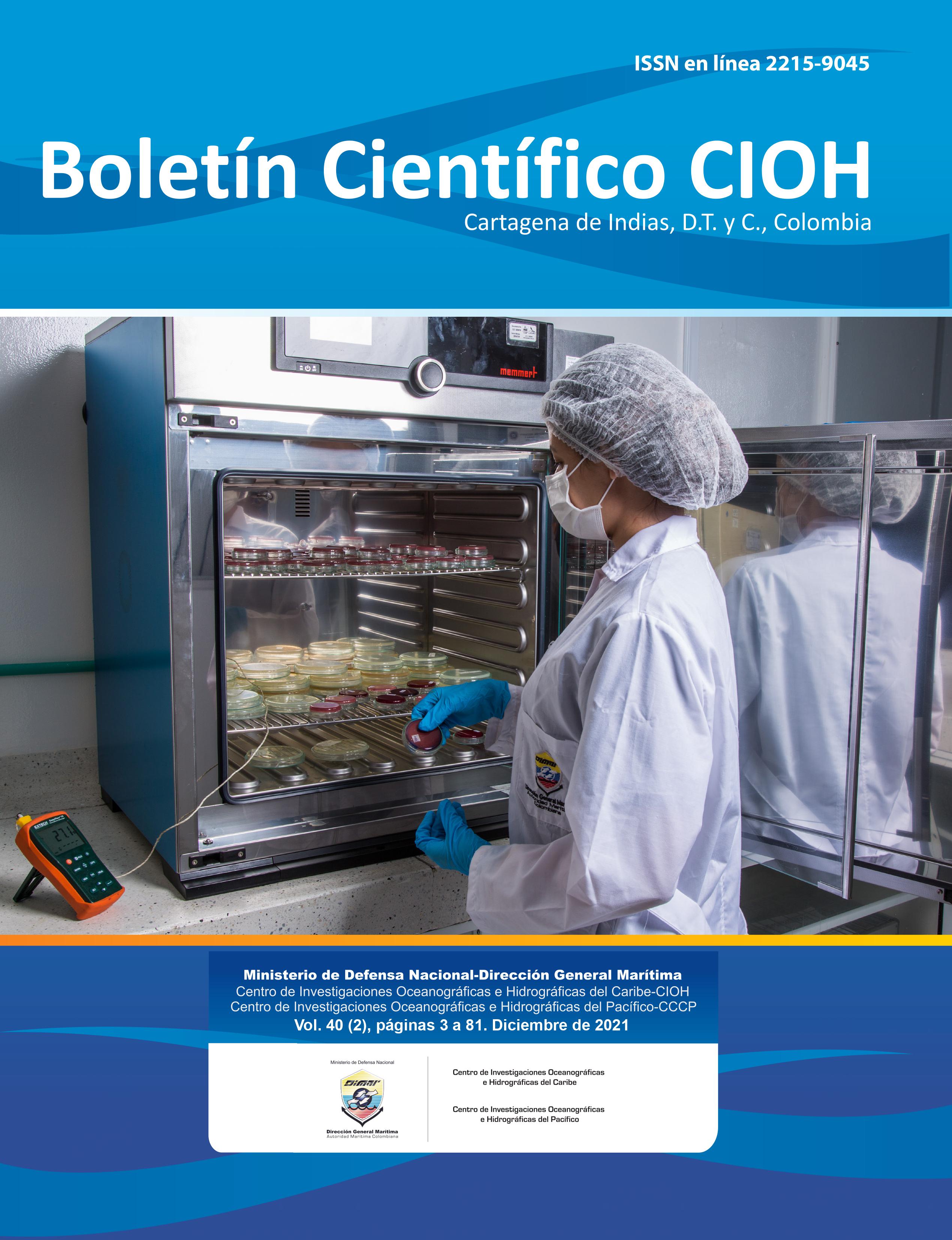Evaluation of the main characteristics of the tidal wave inside the Gulf of Uraba
DOI:
https://doi.org/10.26640/22159045.2021.574Keywords:
Gulf or Uraba, astronomical tide, meteorological tide, tidal harmonicsAbstract
The tidal wave when entering to the estuaries can be modified by morphological and meteorological aspects. Understanding the sea level generated by the tide contributes to the identification of possible flood zones in the event of progressive increases in this sea level associated with climate change and / or sudden changes due to meteorological effects. The Gulf of Uraba is an estuary characterized by having a complex hydrodynamic system affected by oceanographic and atmospheric agents and the presence of the mouth of the Atrato River. Among the oceanographic is the tidal wave. In order to characterize the tide inside the Gulf of Uraba, tide-gauge records located in the district of Turbo (Coast Guard Station) and the municipality of Acandi (Bahía de Sapzurro) were analyzed. Spectral analysis was used to determine the astronomical tide, with which the amplitudes, periods and phases associated with the tidal constituents were obtained. The tidal constituents with the highest amplitudes for both tide gauges were K1 and M2. The behavior of the tide was identified as mixed, mainly semi-diurnal. For the characterization of the meteorological tide, the probability distribution function was used and using data from the reanalysis of atmospheric pressure and wind fields from the ERA5 platform, the correlation of these two variables against variations in the sea level was evaluated. The results suggest that an important percentage of the sea level variations are associated with local effects such as gulf morphology (bathymetry, gulf shape).
Downloads
References
Chevillot, P., Molina A., Giraldo L. y Molina C. (1993). Estudio geológico e hidrológico del golfo de Urabá, Boletín científico CIOH, 14, 79-89.
Dronkers, J. (1964). Tidal computations in rivers and coastal waters. North Holland: Amsterdam.
Fierro,J., Bravo,M. y Castillo,M.(2000). Caracterización del régimen de mareas y corrientes a lo largo del canal Moraleda (43° 54' S - 45° 17' S). Ciencia y tecnología del mar,23,3-14.
García, F., Palacio, C., & Garcia, U. (2011). Constituyentes de marea en la bahía de Santa Marta, Colombia. Dyna, 78(167), 142-150.
GIOC (2002). Documento de referencia. Dinámicas, Volumen I. Cantabria, España: Universidad de Cantabria.
Gutiérrez, F. (2011). Determinación del régimen medio y extremo del nivel del mar, en esteros y ríos con dinámica mareal en la Bahía de Tumaco. Boletín Científico CIOH,29, 110-121.
Hernandez,D., & Romaña,Y.(2018). Patrones de circulación superficial entre los sistemas costeros de punta las vacas y bahía el uno, Turbo, Antioquia (tesis de pregrado).Universidad de Antioquia, Colombia.
Hoyos, I. C. R., Alejandre, T. R. F., & Tobón, C. A. P. (2008). Caracterización del patrón de circulación de las bahías Sapzurro y Capurganá mediante la implementación de un modelo hidrodinámico en dos dimensiones. Boletín Científico CIOH, (26), 47-58.
Malikov, I. (2010). Régimen de la marea en diferentes puntos de las costas colombianas. Instituto de Hidrología, Meteorología y Estudios Ambientales – IDEAM. Bogotá, D.C.
Otero, D. (2004). Determinación del régimen medio y extremal para el nivel del mar para la bahía de buenaventura. Boletín Científico CCCP,(11) , 30-41.
Restrepo, J. D. & Lopez, S. A. (2008). Morphodynamics of the Pacific and Caribbean deltas of Colombia, South America. Journal of South American Earth Sciences. Vol. 25, 1-21.
Toro,V.G., Mosquera,W., Barrientos,N. y Bedoya,Y.(2019). Circulación oceánica del golfo de Urabá usando campos de viento de alta resolución temporal. Boletín Científico CIOH, 38( 2), 26–35, DOI 10.26640/22159045.2019.516
Downloads
Published
Issue
Section
License
Copyright (c) 2021 CIOH Scientific Bulletin

This work is licensed under a Creative Commons Attribution-NonCommercial-NoDerivatives 4.0 International License.
Attribution — You must give appropriate credit, provide a link to the license, and indicate if changes were made. You may do so in any reasonable manner, but not in any way that suggests the licensor endorses you or your use.
NonCommercial — You may not use the material for commercial purposes.
NoDerivatives — If you remix, transform, or build upon the material, you may not distribute the modified material.
No additional restrictions — You may not apply legal terms or technological measures that legally restrict others from doing anything the license permits.



